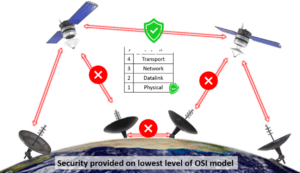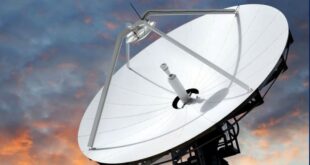By Ronald van der Breggen
 Last weekend I received a link to the presentation that Steve Collar (CEO of SES) gave during GovSatCom22 in Luxemburg late last month. Steve is someone I genuinely respect, and we go back a long time. I fondly remember working with him on a DVB-RCS project back in 2003 that we thought was going to be critically important for the future of our industry, one that became increasingly digital and more focused on data. In hindsight we were certainly right about the importance of data, as for DVB-RCS… Oh well.
Last weekend I received a link to the presentation that Steve Collar (CEO of SES) gave during GovSatCom22 in Luxemburg late last month. Steve is someone I genuinely respect, and we go back a long time. I fondly remember working with him on a DVB-RCS project back in 2003 that we thought was going to be critically important for the future of our industry, one that became increasingly digital and more focused on data. In hindsight we were certainly right about the importance of data, as for DVB-RCS… Oh well.
You will understand that when I get sent something about Steve, I pay attention and today’s video was no exception. What did catch my attention immediately was that in the opening sentences of his presentation, he addressed the situation in the Ukraine that was just unfolding at the time. This made me instantly press ‘pause’ and flip the video to the big screen. If the CEO of the biggest satellite company in the world was going to talk politics and world affairs, then I needed to make sure to catch it in all its detail. Fully settled in and now seeing my former colleague lifesize, I continued watching.
Apolitical
Much to my disappointment however, Steve quickly steered clear of anything related to the Ukrainian war. Instead, he started talking about O3b mPower and how its design and SES’ multi-orbit strategy fits very well with today’s GovSatCom requirements, and how well a commercial organization like SES can work together with Governments. To say that I was disappointed with this follow up of the presentation is actually unfair: Steve did exactly what he had to do, which is to find an area of neutrality allowing him to present the value of SES and how O3b mPower’s coverage, latency and capacity features brings all sorts of interoperability, resiliency and global connectivity benefits. Any great speaker, certainly when CEO, would have done exactly the same. First, it makes good business sense but secondly, in our industry we don’t like to get involved in politics.
Our industry is global almost by nature and while any choice for either a red or a blue team of course limits business options, it also limits the industry’s capabilities to provide disaster relief and recovery services, as well as other humanitarian and welfare operations. As much as it feels good to take the moral high-ground and tell a government of questionable reputation you will not do business with them, we are all too well aware that in doing so, we have now also taken away the opportunity for any and all residents in that country to point a dish at your satellite through which in times of crisis you can provide all sorts of relevant information pertaining to the situation at hand. We collectively have a rich tradition in this area and our industry has stepped up in meaningful ways during many times of crisis. Starlink has recently demonstrated that today’s events in the Ukraine are no exception. Ironically our desire and reputation to do so is well rooted in our history of politics: The inception of our industry can be traced back to the politicians of the 1960’s, particularly to those in the UN. Not sure how it makes sense or to what extent it is even relevant, but it sure is ironic: This industry has a history of being apolitical while it stems from politics!
Security
Back to SES’ presentation at GovSatCom22. As much as Steve did everything right by SES, there is a deeper layer here that requires further attention and analysis. It can be captured in one word: Security.
During the rest of the presentation, SES puts forward their O3b mPower constellation as one that is ideal to support government and military missions: It is high-capacity and low latency, interoperable with anything terrestrial because of its open architecture, and resilient because it is space-based and even more difficult to interfere with then GEO infrastructure. While all of that is true, in the context of the Ukraine and fighting wars, it left me feeling a bit uncomfortable. It felt like making the argument you have the perfect vehicle for a military ground mission because it is fast and easy to drive, because it can haul a lot of cargo and has great mileage. All good stuff, but if you are the one going on a mission, then something tells me you are only interested in one single thing: “If people start shooting at me, will I live or will I die?”. Personal security and mission integrity is everything, the rest is a side issue. In terms of telecommunication this is the difference between a message being intercepted or not. If security cannot be assured to an acceptable level, further planning is required. While for military operations in the field this could mean a different route or a more heavy armored vehicle, for telecommunication systems the risks are less easy to identify and solve. Consequently, missions may have to take on unnecessary risks or be scrapped altogether, both of which may have serious consequences for positive outcomes of disputes and conflicts. If we as an industry can help prevent that by offering better services, than we share the responsibility for when positive outcomes are delayed or cannot be achieved.
So what is the issue at hand then? What can we do better as an industry from a security perspective? Before going into that it needs to be said that I feel a bit uncomfortable positioning telecommunication security as the be all and end all, because I sat at the exact other side of the argument 30-years ago. Back in the mid-nineties when I worked for Dutch telecom incumbent KPN, I was convinced that the internet was going to be a huge business opportunity, one that KPN could not afford to miss out on. My critics within the company said that the internet would never be successful, because of the absence of secure networking, emailing and access to information. X.25, FR, ATM and X.400 mail would instead be the future for that very reason. That resulted in fierce debates in which I basically dismissed the entire security argument as ridiculous; it was all about access to information and security would sort itself out. Fast forward 30 years and we all know how that ended, but how can I now hold up Security as critically important today, while completely dismissing it as irrelevant 30 years ago? Or better put: Why did security issues not stand in the way of the success of the internet, but why will it now be critically important for the success of the satellite industry?
Physical infrastructure vs. physical layer
 For that to understand we need to contextualize the times in which we live(d). In the mid-nineties there was a huge business opportunity for internet access and distributed networking. Everything else came in second, including security. In today’s day and age, for satellites, the exact opposite is true. Merely adding infrastructure to access the internet is marginal business at best; but with cybercrimes rampant and countries at war, being able to secure traffic and transactions is a massive requirement and consequently, a massive responsibility – or opportunity if you want. As much as SES and other satellite operators are talking about security, it is usually in the context of secure ground infrastructure, ie. connecting satellites in a secure way to terrestrial networks for connectivity or datafeeds. While not unimportant, real security comes with eliminating ground infrastructure altogether and linking designated end-points exclusively using satellite infrastructure. This way security is offered on a physical level, the lowest layer of the OSI-model. Today that is already possible if said points are within the same beam or footprint of one single satellite. This however gives a very limited area to operate within and when satellites start being deployed closer to earth through MEO and LEO constellations, these beams only get smaller. While latency is improving, location flexibility becomes less and less, along with the number of use cases that can now be supported.
For that to understand we need to contextualize the times in which we live(d). In the mid-nineties there was a huge business opportunity for internet access and distributed networking. Everything else came in second, including security. In today’s day and age, for satellites, the exact opposite is true. Merely adding infrastructure to access the internet is marginal business at best; but with cybercrimes rampant and countries at war, being able to secure traffic and transactions is a massive requirement and consequently, a massive responsibility – or opportunity if you want. As much as SES and other satellite operators are talking about security, it is usually in the context of secure ground infrastructure, ie. connecting satellites in a secure way to terrestrial networks for connectivity or datafeeds. While not unimportant, real security comes with eliminating ground infrastructure altogether and linking designated end-points exclusively using satellite infrastructure. This way security is offered on a physical level, the lowest layer of the OSI-model. Today that is already possible if said points are within the same beam or footprint of one single satellite. This however gives a very limited area to operate within and when satellites start being deployed closer to earth through MEO and LEO constellations, these beams only get smaller. While latency is improving, location flexibility becomes less and less, along with the number of use cases that can now be supported.The good news is that there still is a world of opportunity out there for everyone in our industry. By connecting satellites through laser and by allowing them to carry traffic over long distances from satellite to satellite in space, creating a path that does not include any terrestrial network, the industry will significantly reduce, if not eliminate the network’s threat-surface as we know it today. Forget about the false sense of security of a VPN, this is about the physical reality of an RPN, a Real Private Network. What I have already said many times to be a compelling architecture for many corporate and government applications, has now become critical in a world where conflicts seem to last unnecessarily long and appear to arise out of our inability to get the right information and cold hard facts in the hands of people who have a right to know. As an industry we should be aware that we have an opportunity – therefore a responsibility to become of force for good from our position of privilege. Easy to say, I know, but therefore not less true.
Conclusion
Our industry, while created by politicians, has a history of being apolitical. A big part of the explanation is that satellites are instrumental in disaster relief and recovery as well as other humanitarian projects. Recent events in the Ukraine confirm that. Our ability to act quickly in times of need, is predicated on building all necessary relationships in a very complex geo-political system.
During times of conflict, secure communications become critically important to save lives. Satellites already play an important role here, but there are opportunities to do better. For businesses this comes with the requirement to start developing satellite systems that offer end-to-end secure communication through space via dedicated channels. For governments this comes with the responsibility to invest in satellite systems that offers its citizens unbridled access to facts and information even when the government itself is under duress.
As for the satellite industry… Given recent events it is clear that we live in a world where people want to increasingly unite behind other things than a nation’s flag and the doctrine it stands for. It’s quite intuitive to assume that our global communication infrastructure will play a key role in support of this ongoing development. I can only hope that the science and fact-based nature of our industry is an inspiration for us all to do so responsibly.
Meanwhile my thoughts go out to the many Russian citizens who vehemently disagree with what their government is doing but are now isolated and stigmatized through no fault of their own, but most importantly to all Ukrainian people who stand to lose so much, if not everything at all.

Ronald van der Breggen, Owner of Route206, has more than 20 years of experience in the telecom and satellite sectors. A native of the Netherlands, van der Breggen began his telecom career at Dutch Telecom incumbent KPN, rising to the position of VP IP Services. He then joined SES, one of the world’s leading satellite operators as Vice President Customer Account Management. From 2015 to 2019 he served as Chief Commercial Officer of LeoSat, where under his leadership the company secured $2 billion in pre-launch commitments. With Route206, Ronald continues to help companies with brilliant technology to achieve commercial success through his decades of experience, structured approach and large industry network. Ronald holds a Bachelor’s degree in Business Administration from Nijenrode University as well as a Masters in Business Telecommunications from the Technical University of Delft, both in the Netherlands.
This article was originally published on LinkedIn. You can read the original here.





